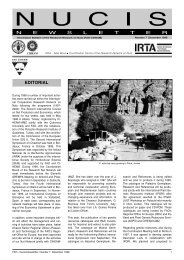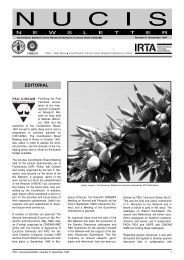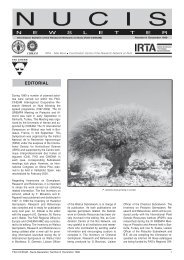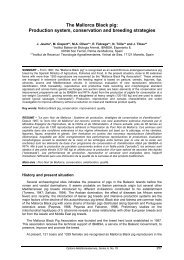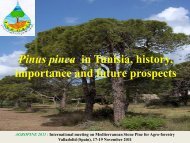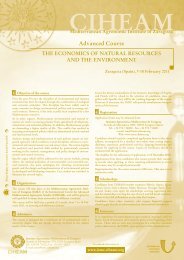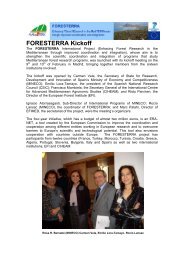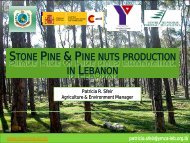NUCIS number 12. September 2004. 52 pages (full ... - IAMZ - ciheam
NUCIS number 12. September 2004. 52 pages (full ... - IAMZ - ciheam
NUCIS number 12. September 2004. 52 pages (full ... - IAMZ - ciheam
- No tags were found...
You also want an ePaper? Increase the reach of your titles
YUMPU automatically turns print PDFs into web optimized ePapers that Google loves.
Table 1. Pistacia species growing inthe germplasm collection at BIDR andtheir geographical origin.Pistacia speciesOriginP. atlantica CyprusIsraelSpainSyriaP. chinensis USAP. khinjuk SyriaP. lentiscus CyprusIsraelTunisiaSpainP. palaestina IsraelSyriaP. terebinthus SyriaP. vera TurkmenistanSyriaFig.1. View of accessions of Pistacia atlantica(front) and Pistacia lentiscus (back) growing inthe germplasm collection at BIDRZohary (19<strong>52</strong>), in his famous monographon Pistacia spp. divided the eleven speciesof the genus into four different sections(Fig. 2). The three evergreen speciesof the genus: P. lentiscus, P. weinmanifoliaand P. saportae were includedin the section EU Lentiscus; the two Americanspecies were clustered in the sectionLenticella; in the section EU Terebinthushe included the five species P. terebinthus,P. palaestina, P. vera, P. khinjuk,and P. chinesis, while P. atlantica wasseparated into a single section Butmela(Zohary, 19<strong>52</strong>). Studies conducted atBIDR germplasm collection on the relationshipamong Pistacia species usinggenetic marker techniques (Golan-Goldhirshet al., 2004) and morphological descriptors,support Zohary’s division of thegenus (Fig. 2). However, while parsimonyanalysis of the morphological descriptorsclustered the six studied species accordingto Zohary’s division, molecular techniquesanalyses (AFLP and RAPD) includedP. atlantica, P. vera and P. khinjuk inthe same genetic subgroup. The geneticclustering indicated that the genetic distancebetween P. atlantica and P. vera-P.khinjuk was smaller than that of the lattertwo species to P. terebinthus-P. palaestina(Fig. 2). We assume that the sameFig. 2. Genetic markers and morphological descriptors clustering of six Pistacia species (bottom) incomparison to the classical division of the genus as was proposed in 19<strong>52</strong> by Zohary (top)center of distribution of P. vera, P. khinjukand P. atlantica in central Asia is thecause to the close genetic relationsamong these species. However, a muchdeeper study, such as alignment of genomicnucleotide sequences of conservedgenes, might assist in deciphering thephylogenetic tree of Pistacia sp.The germplasm collection at BIDR includesaccessions of P. vera that were developedfrom seeds collected from Badghiz,Turkmenistan. There, natural standsof P. vera still exist in two populations,Kepele and Agachli, close to the Iranianand Afghan borders. Plant growth parameters(plant height and trunk diameter)over two years of measurements at thecollection site indicated that accessionsfrom Agachli had higher growth rate thanthese of Kepele. Statistical analysisshowed that these differences were significantat 96% and 94% levels for plantheight and trunk diameter, respectively(Barazani et al., 2003). Agachli accessionscan therefore be considered for futurebreeding programmes of P. vera.Moreover, significant statistical relationwas found between plant growth rate andthe genetic matrix as was assessed byRAPD (Barazani et al., 2003). Trees inthe two populations, Kepele and Agachli,although geographically close, grow indifferent habitats, which probably led tothe genotypical differences.The pistachio tree is an important nutcrop in many countries. However, P. atlantica,P. khinjuk, P. palaestina and P.terebinthus are used by local farmers inthe Middle East as rootstocks for graftingof P. vera. Therefore, wild relatives ofhorticultural cultivars may be useful stockmaterial for breeding programmes (Zohary,1995), pointing to the significance ofpreservation of the genetic variability.Increasing concern on loss of genetictraits has led, over the last decades, toconservation plans and more effort togene banks management, as well as establishmentof germplasm collections ofwild relatives of economically importantcrops. We destined the Pistacia spp. livegermplasm for this purpose and for selectionof suitable genotypes for future breedingprogrammes.ACKNOWLEDGMENTSThis research was supported in part underGrant No. TA-MOU-98-CA17-028 fundedby the U.S. – Israel Cooperative DevelopmentResearch Program, Bureau forEconomic Growth, Agriculture, and Trade,U.S. Agency for International Development.REFERENCESBarazani, O., Atayev A., Yakubov B.,Kostiukovsky, V, Popov, K., Golan-Goldhirsh,A. 2003. Genetic variability inTurkmen populations of Pistacia vera L.Genet. Resour. Crop Evol. 50: 383-389.Golan-Goldhirsh, A., Kostiukovsky, V.1998. Mediterranean Pistacia genusgermplasm collection at Sede Boker Israel.Acta Hort. 470: 131-137.Golan-Goldhirsh, A., Barazani, O.,Wang, Z.S, Khadka, D.K., Saunders,J.A., Kostiukovsky, V., Rowland, L.J.<strong>2004.</strong> Genetic relationships among MediterraneanPistacia species evaluatedBy RAPD and AFLP markers. PlantSyst. Evol. (in press).IPGRI. 1997. Descriptors for Pistachio(Pistacia vera L.). International PlantGenetic Resources Institute, Rome,Italy.Zohary D. 1995. The genus Pistacia L.In : Padulosi S., Caruso T., Barone E.(eds.) Taxonomy, distribution, conservationand uses of Pistacia genetic resources.IPGRI, Italy, pp. 1-11.Zohary M. 19<strong>52</strong>. A monographical studyof the genus Pistacia. Palestine J. Bot.(Jerusalem Series) 5: 187-228.O. Barazani and A. Golan-GoldhirshBen-Gurion University of The Negev, TheJacob Blaustein Institute for Desert Research,Albert Katz Department of Dryland Biotechnologies,Desert Plant Biotechnology Laboratory,Sede Boqer Campus 84990, IsraelE-mail: avigolan@bgumail.bgu.ac.il32 FAO-CIHEAM - Nucis-Newsletter, Number 12 <strong>September</strong> 2004



